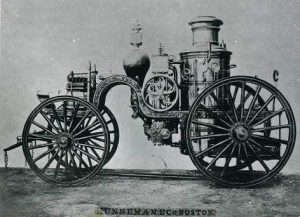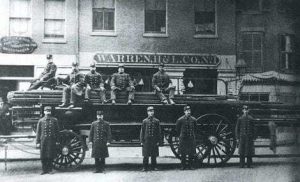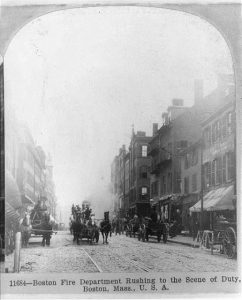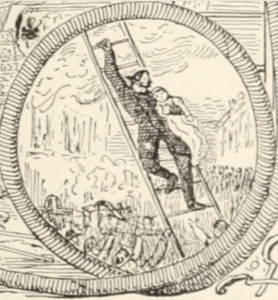Fighting Rebels and Fighting Fires: The Life of George F. Griffin (Part 2/2)
The grizzled veteran George F. Griffin, having survived the war’s gruesome last year, was mustered out of service on July 12, 1865.
He had lost two brothers, one even mortally wounded by his side. But now Griffin had his entire life ahead of him, and he soon settled in Boston. His military service was over, but his service to the people of Boston was just beginning.
George Griffin married Elizabeth Coyle on July 1, 1866. The two had five children before her death in 1879 from chronic gastritis. To support his growing family, Griffin earned a living as a carpenter, and in that capacity he began to both create and fix the ladders used by the Boston Fire Department. “This is no small item, as this department averages twelve hundred feet of ladders per year,” that required repair, according to a history of the department. Griffin’s experience around the ladders ultimately led to him joining the department in 1868 as a paid-on-call firefighter with Hook & Ladder Co. 1.[1]
To understand George Griffin’s developing career with the Boston Fire Department, let’s pause to examine what life was like for a 19th century firefighter. The first thing to understand is that these were professional firefighters. Before the Civil War many cities like New York had all volunteer companies, and there are many, many stories of how rival firefighting companies would arrive on the scene of a conflagration and spend more time battling each other than fighting the flames. But Boston could boast having the country’s oldest paid fire department, the city having established such a service in 1678. By 1872 the department had grown to have more firefighters than even London’s Fire Brigade.[2]
Not everyone in the department were full-time firefighters. George Griffin, for example, only got paid for the fires he attended; he was thus an “on-call firefighter,” at least at the start of his career. Boston’s firefighters, whether they were full-time, part-time, or on-call, generally served on one of two different apparatuses: engine companies, or ladder companies. Then, as now, it is an engine company’s primary responsibility to extinguish the fire. The engine companies laid hoses, charged lines, and fought the fire. Ladder companies, on the other hand, gained access to the burning structures and conducted primary search and rescue operations. They entered the burning buildings most often without the support of a hose line and rescued victims who may be trapped inside. From his time entering the department in 1868, George Griffin would spend the next thirty-one years as part of a ladder company.[3]

Hook & Ladder Co. 1 was located at 152 Friend Street in North Boston (for the more-modern inclined, just a few blocks from the site of TD Garden). It was an apparatus that carried “18 ladders of various lengths, 4 axes, 4 rakes, 6 guy ropes, 2 lanterns, 2 fire-hooks and ropes, 1 crow-bar, 2 pick-axes, 4 shovels,” and a wide variety of other tools useful at a fire. The entire rig “as drawn to fires,” weighed 7,085 pounds, and had a complement of twenty-one firefighters assigned to it. George Griffin’s role was listed as “axeman,” in a register of firefighters within the city just a few years after joining the department.[4]

The biggest fire of George Griffin’s career came on Nov. 9, 1872, just four years after joining the department. It started in the basement of a warehouse on Summer Street, about a mile from Ladder Co. 1’s firehouse. Twelve hours later the Great Boston Fire of 1872 had burned through sixty-five acres of buildings, caused $75 million in damages, and killed an estimated eleven firefighters.[5] The fire hit Boston when its department’s horses, used to pull its engines and ladder companies, were severely under-strength from widespread horse flu. Without horses, many of the department’s companies had to be hand-pulled to the fire, allowing the fire to grow in size. Even with all the problems, Ladder Co. 1 got to the fire within six minutes of receiving the call.[6] Ladder Co. 1 was just one of many companies responding to the fire; numerous alarms were called throughout the night, and towns outside of Boston sent their crews to help while boats in Boston’s inner harbor used water cannons to try and prevent the spread of the flames. Throughout the night Boston’s firefighters, including Griffin, battled the blaze and tried to prevent the spread of the raging inferno.

George Griffin had proven himself as a capable firefighter, and a year after the Great Fire was promoted to Captain of Ladder Co. 8. His new posting had Griffin in downtown Boston, and he found himself constantly responding to fires throughout the city. It did not come without a cost. “Years ago at a fire in Partridge’s store he fell and fractured his right leg,” a newspaper account read in 1900. The injury, just one of many throughout his career, kept Griffin “off duty almost a year.”[7] In another fire “a falling ladder severed the muscles of both arms.”[8]
Griffin sought ways to improve firefighting and keep his men safe from the same injuries that plagued him. He was credited for inventing both “a life-saving gun for shooting a line into a window,” and a “harness, which has proved of incalculable assistance in carrying persons who are unable to walk from a building.”[9]
Then came the fire on Travers Street just after midnight on April 19, 1880. Like so many times before Griffin ran into the burning structures so that others may live. He led Firefighter E.B. Smith, also from Ladder 8, into the inferno. The two of them, and Firefighter L.F. Stevens, from Griffin’s old Ladder No. 1, found many trapped victims inside. “Several of the inmates of the building were rescued by members of the department in an exhausted condition,” read the fire department’s official report. But those “inmates” were, more specifically, a mother and her five children.[10]
The trio’s heroics did not go unnoticed. The Boston Fire Department had created a Roll of Merit to recognize the outstanding actions of its firefighters in 1880. Since its inception, 468 firefighters have been added to the roll– many of them dying in the line of duty. The Travers Street fire resulted in the first three names being added– Capt. George Griffin appears second.[11]
Griffin’s storied career continued into the 1890s. He transferred to Brighton, which at one time was a suburb west of Boston’s downtown. And in 1899, after thirty-one years of fighting fires from a ladder company, Griffin was promoted to Chief of District 11. He now oversaw three engine companies, one chemical company, and one ladder company. From his days as an on-call firefighter, getting paid for only the fires he attended, Griffin now made $2,000 a year.[12]
Griffin retired a year later in 1900 when he reached the department’s compulsory age of sixty-two. “Chief Griffin leaves behind him an honorable record for bravery in the line of duty, to which the many scars he bears upon his body bear conspicuous testimony,” a paper noted. “In all his experience in the fire department, he never had the slightest trouble, either with a superior officer or with the men under him. . . and will carry with him the good will of every officer and man in the department.”[13]

He was an active member of the Grand Army of the Republic, both before and after retirement. And when George Griffin died in 1909, representatives from both the G.A.R. and the Fire Department attended his funeral. Old veterans, too, from the 56th Massachusetts showed up, to remember a comrade who was with them under a different kind of fire in 1864. With six firefighters acting as pallbearers they buried a man who had more than proven himself. For both his country, and his city, George Franklin Griffin fought. He is buried today in Woodlawn Cemetery in Everett, Massachusetts, just a few miles outside of Boston.[14]
______________________________________________________________
[1] Arthur W. Bailey, A Complete History of Boston Fire Department, Vol. 2 (Boston: John P. Dale & Co., 1889), 443.
[2] Bruce Hensler, Crucible of Fire: Nineteenth-Century Urban Fires and the Making of the Modern Fire Service (Washington, D.C.: Potomac Books, 2011), 111.
[3] Engine and ladder companies were supplemented with other apparatuses such as chemical engines and hose companies, which also had their own role in firefighting operations.
[4] Documents of the City of Boston 1873, Vol. 2, City Document No. 58 (Boston: 1873) 76.
[5] Hensler, 113;
[6] Documents of the City of Boston 1873, Vol. 2, 646.
[7] Boston Globe, Oct. 17, 1900; Bailey, 443.
[8] Boston Globe, Oct. 22, 1900.
[9] Boston Globe, Oct. 17, 1900.
[10] Documents of the City of Boston, 1880, Vol. 2 City Document No. 58(Boston: 1880) 238; Boston Post, April 22, 1880.
[11] Boston Fire Department Roll of Merit. E.B. Smith and L.F. Stevens were also recognized and added for their actions in the fire.
[12]Annual Report of the Fire Department For the Year 1895 (Boston: Rockwell and Churchill, City Printers, 1896), 4-5, Annual Report of the Fire Department for the Year 1897, 7.
[13] Fire and Water, Nov. 10, 1900, 185
[14] Boston Globe, May 22, 1909.

Great Story! Thanks for sharing.
Thanks for the kind comment!
Great story. You feel like you get to know him and I may have missed it, but want to know what yunit he serviced with during the War, so you could get to know his story a little more.
Hi, thanks for commenting. Griffin served in the 56th Massachusetts Infantry. You can read about his service in the war in the first part, here: https://emergingcivilwar.com/2019/11/25/fighting-rebels-and-fighting-fires-the-life-of-george-f-griffin-part-1-2/
Nice story, Ryan. Too bad we don’t have any letters or a journal written by him during the war to shed light on his experiences and thoughts. Even without that, though, you brought him to life. It’s great you were able to follow his story into civilian life and his career as a firefighter in Boston.
Thanks for the comment, Rob. I too wish there were some written recollection from Griffin. But I think Griffin’s story is also a reminder that the Civil War was just a small portion of these peoples’ lives. We spend so much time and energy on the war itself, and very rarely follow-up what came next. Griffin’s rise through the fire department, and the mountain of records that at least existed for that, allowed me to track his time in the fire service fairly easily.
Yeah, I agree. It’s interesting and worthwhile, I think, to follow a veteran’s post-war experience. It certainly was worthwhile in Griffin’s case. To get some more exposure for your story in Boston, you might consider sending a link to your blog piece to some BFD officials, like at the BFD Facebook page or official newsletter, and suggest that they publish and plug the link. There are a whole lot of firefighters in the department, and I’ll bet some of them would be interested. They’ll have to love the historical info you provide on their department.